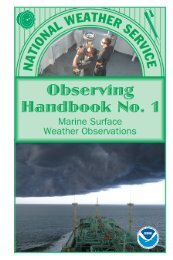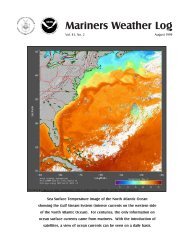Volume 56, Number 3 December 2012 Photo by Denice Drass
Volume 56, Number 3 December 2012 Photo by Denice Drass
Volume 56, Number 3 December 2012 Photo by Denice Drass
Create successful ePaper yourself
Turn your PDF publications into a flip-book with our unique Google optimized e-Paper software.
North Atlantic Area<br />
<strong>December</strong> <strong>2012</strong> ~ Mariners Weather Log<br />
36<br />
later with the center near 44N 54W.<br />
The Nedlloyd Maxima (A8JR6) near<br />
40N 59W reported northwest winds of<br />
50 kts and 9.8 meter seas (32 feet) at<br />
2100 UTC on the 3 rd . The Sea-Land<br />
Mercury (WKAW) encountered seas<br />
of 10.4 meters (34 feet) along with<br />
northwest winds of 35 kts near 40N<br />
58W twelve hours later. Blocked <strong>by</strong><br />
high pressure to the east, the cyclone<br />
lifted north across Newfoundland on<br />
the 4 th and weakened before becoming<br />
absorbed <strong>by</strong> another cyclone to the east<br />
<strong>by</strong> the 6 th .<br />
North Atlantic Storm, April 14-<br />
15: Low pressure moved off the mid<br />
Atlantic coast of the U.S. early on<br />
April 11 th and moved to near the island<br />
of Newfoundland on the 13 th before<br />
intensifying into a hurricane force low<br />
south of Greenland late on the 14 th<br />
(Figure 22). A high resolution ASCAT<br />
pass near the time of the second part<br />
of Figure 22 showed northeast winds<br />
to 70 kts north of the occluded front<br />
where the flow is channeled against<br />
the southern tip of Greenland. This<br />
was the last non tropical hurricane<br />
force event of the period. The cyclone<br />
subsequently slowed down southeast<br />
of Greenland and weakened late on<br />
the 15 th before moving southeast and<br />
becoming absorbed <strong>by</strong> the 17 th .<br />
Northeastern Atlantic Storm,<br />
May 12-14: Figure 23 shows the<br />
development of an unseasonably deep<br />
storm center north of Great Britain<br />
from a low pressure wave near 60N<br />
36W over a thirty six hour period. This<br />
was almost as deep as the post tropical<br />
storm Beryl described above. The<br />
central pressure dropped 33 mb in the<br />
twenty four hour period ending at 1200<br />
UTC on the 13 th , as rapid a drop as in<br />
some of the winter storms. The buoy<br />
63057 (59.2N 1.5E) reported southwest<br />
winds of 50 kts at 0200 UTC on the 14 th ,<br />
and seas up to 6.0 meters (20 feet) four<br />
hours later. The Stena Carron (2BKQ8)<br />
near 61N 3W encountered northwest<br />
winds of 35 kts and 8.2 meter seas<br />
(27 feet). The cyclone subsequently<br />
weakened and moved through the<br />
Norwegian Sea as a gale on the 15 th .<br />
Central North Atlantic Storm, May<br />
30-31: The low pressure complex<br />
seen over the central waters in the<br />
first part of Figure 24 consolidated<br />
into one 976 mb low near 50N 34W <strong>by</strong><br />
1200 UTC on the 31 st with the 990 mb<br />
low coming from the west absorbing<br />
the others. This became the southern<br />
low with storm conditions seen in the<br />
second part of Figure 24. The Kiel<br />
Express (DEHZ) reported southeast<br />
winds 45 kts near 49N 27W at 0600<br />
UTC on the 31 st , and 5.8 meter seas<br />
(19 feet) three hours later. Figure 25 is<br />
an OSCAT image of the consolidating<br />
cyclone circulation containing storm<br />
force winds. Weakening of this slow<br />
moving system followed on the 31 st<br />
as the system drifted to the west and<br />
became absorbed <strong>by</strong> the intensifying<br />
post tropical Beryl turning north toward<br />
it early on June 3rd.<br />
Northeastern Atlantic Storm, June<br />
14-15: A low pressure wave near<br />
Bermuda early on June 9 th moved<br />
northeast and intensified as it turned<br />
north toward Ireland late on the 13 th<br />
and the 14 th , becoming a storm force<br />
low near 50N 12W with a lowest central<br />
pressure of 984 mb at 1800 UTC on the<br />
14 th . The system drifted to the north<br />
and weakened to a gale near Ireland on<br />
the 15 th , before turning northeast and<br />
dissipating in the North Sea on the 17 th .<br />
Buoy 62023 (51.4N 7.9W) reported<br />
southwest winds of 39 kts with gusts to<br />
49 kts at 1800 UTC on the 15 th , and seas<br />
of 5.5 meters (18 feet) seven hours later.<br />
rEFErENCES<br />
Bancroft, George, Marine Weather<br />
Review – North Atlantic Area July to<br />
<strong>December</strong> 2011, Mariners Weather<br />
Log, Vol. <strong>56</strong>, No. 2, August <strong>2012</strong>.<br />
ASCAT Users Manual,<br />
http://www.knmi.nl/scatterometer/<br />
publications/pdf/ASCAT_Product_<br />
Manual.pdf<br />
Von Ahn, Joan. and Sienkiewicz, Joe,<br />
Hurricane Force Extratropical Cyclones<br />
Observed Using QuikSCAT Near Real<br />
Time Winds, Mariners Weather Log,<br />
Vol. 49, No. 1, April 2005.<br />
Sienkiewicz, Joe and Chesneau, Lee,<br />
Mariner’s Guide to the 500 Millibar<br />
Chart, Mariners Weather Log, Vol. 52,<br />
No. 3, <strong>December</strong> 2008.<br />
http://manati.star.nesdis.noaa.gov/<br />
products.php






